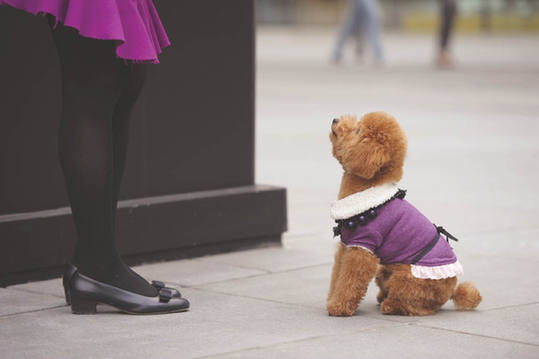| Putting on the Dog
By staff reporter PENELOPE COLVILLE
IF the term had been coined here, the "cat walk" of the West would have been a "dog walk" in the Middle Kingdom. The Chinese are "putting on the dog," but the old expression for dressing up in one's fanciest and conveying the impression of living large, is being given new life in the East. Mao once declared the pampered pet a disgracefully bourgeois habit, but modern China's burgeoning urban middle class, the DINKS (double income no kids) and empty-nesters are taking to pet ownership in a big way. While birds or a collection of tropical fish are considered to be the traditional, classic Chinese pets, the canine is the new darling. Any trend taking hold in China tends to create a rush on the market right at the outset, as the numbers of consumers are so large. This one has unleashed both the frivolous and the serious, from the predictable social front of animal rights crusaders to the much more surprising advent of a riveting and clever dog fashion industry with Chinese characteristics that truly set it apart.
 |
|
Nip and tuck fashion – Andie Zhang convinces her dog Ido to model one of her cotton fleece-lined dog dresses. |
Other than the pampered pets of the court, such as the Pekinese and the Shih Tzu, there is little precedent for the dog as pet among the Chinese rank and file, except as a work animal. The nation's dog clothes designers have therefore been free to take the industry in any direction, and the "dog walk" is a source of endless delight, bringing about canine Halloween costumes, silk pajamas and bumble bee outfits for spring (complete with wire-supported gossamer wings and velveteen antennae). Nail polish and hair dye followed. While many experts lament the anthropomorphic aspects of dog clothing, the ascendancy of the dog's popularity in Chinese cities has actually brought about better care conditions for canines, felines, and a host of other small mammals. And China's attitude towards the beloved pet signals it may be a compensation for the one-child policy, meaning dogs sometimes enjoy some of the freedoms common to canines in Europe, with café owners bringing their pets to work and looking the other way when customers arrive with their own leashed companions.
Dogs welcomed as members of the family appear to be as coddled as the Chinese child, complete with wardrobe. The publishers of Dog Fans and Cat Fans run a seasonal analysis on trends in dog fashion, and editor Wang Ran confirms the pages devoted to advertising all kinds of pet products in these magazines just continue to grow. Japanese designers are still the taste-makers in the clothing industry, but the garments are manufactured in China. Chinese designers who go it alone and market their goods online have trouble with intellectual property theft, finding "knock-offs" of their designs up on the net only weeks after release.
Online isn't for Andie Zhang who recently made a deal with China's biggest pet store chain to provide its own line of dog clothes. An animal lover who knows trends turn into industries overnight here, she went off to study clothing design in Italy for a year at the Instituto Marangoni. Then the 24- year-old returned to China to start her own dog clothing line called AndI. The canine fashionista confesses to much the same preoccupations as a regular designer: she considers the temperament and size of the breed to create outfits with either elaborate or sleeker styles and warmer or cooler palettes that match up with the characters of terriers or poodles, accessory-sized or large family dogs. The roots of her inspiration are personal; her poodle Ido was a gift from a friend, and when she went to the pet stores she couldn't find a thing for the dog to wear.
Objections from hardline animal lovers everywhere is that dogs have hair to keep them warm and furthermore, any clothing masks the dog's body language – which is how the animals communicate with each other. On the more practical side however, an indoor animal in China is more than likely an apartment-housed creature with no chance to grow protective hair for the winter. A coat is at least practical, as are boots to protect pads from winter ice and salt. Making dogs look good is not Zhang's only mission anyway; the young designer is concerned with the whole fertile territory of the human-pet relationship, explaining, "Clothes were just the easiest entrée to the market; from here on I am thinking about bowls, leashes, toys, and furniture."
|
